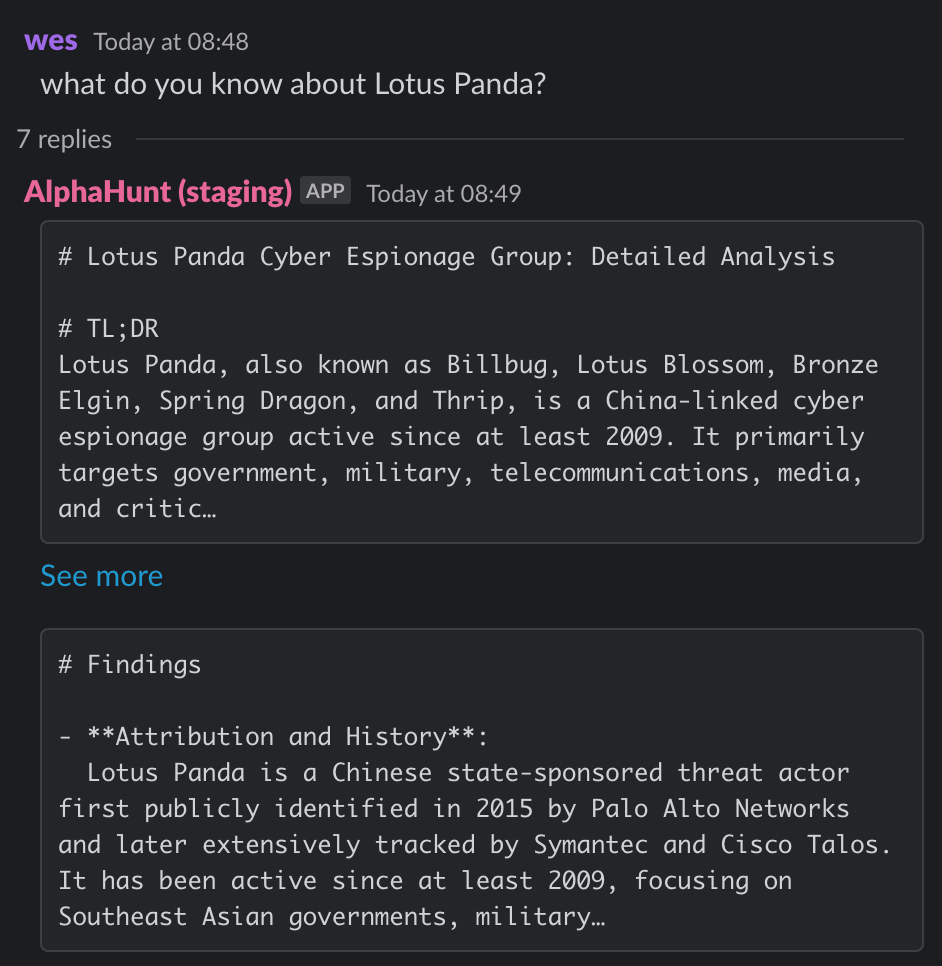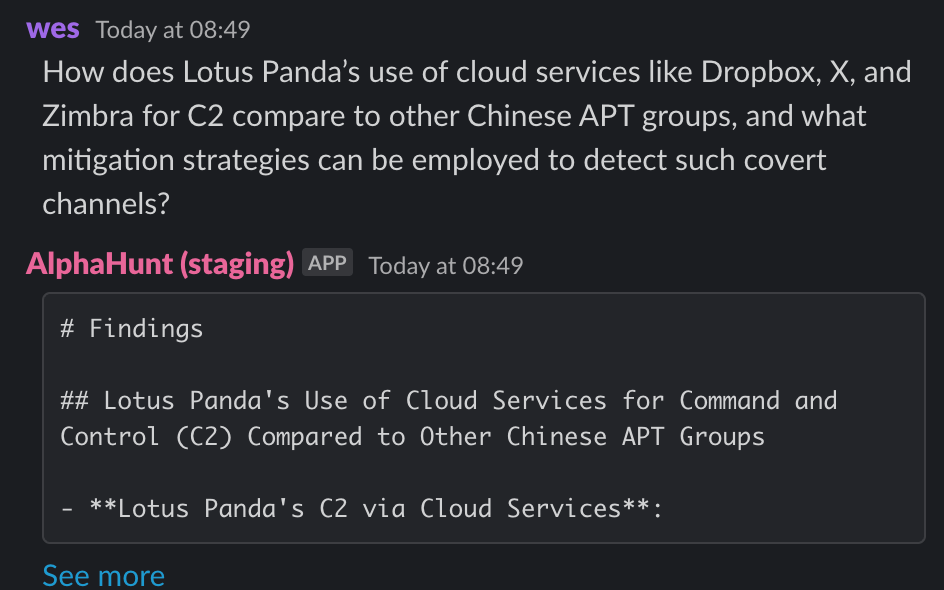Lotus Panda's Multi-Cloud C2 Evolution: Advanced Espionage Tactics Targeting Southeast Asia
Lotus Panda (aka Lotus Blossom, Spring Dragon, Billbug, Bronze Elgin, Bitterbug) is a Chinese state-sponsored APT group active since at least 2009, specializing in cyber espionage against Southeast Asian governments and critical sectors.



(Have feedback? Did something resonate with you? Did something annoy you? Just hit reply! :))
Get questions from your boss, like this:
- what do you know about Lotus Panda?
- How does Lotus Panda’s use of cloud services like Dropbox, X, and Zimbra for C2 compare to other Chinese APT groups, and what mitigation strategies can be employed to detect such covert channels?
Are you ready to level up your skillset? Get Started Here!
Suggested Pivot
What specific indicators of compromise (IoCs), behavioral patterns, and telemetry signatures from endpoint and network data are associated with the latest Sagerunex backdoor variants? How can these be operationalized using EDR tools, network sensors, and threat intelligence feeds to enable real-time detection and automated response?
TL;DR
Key Points
-
- Lotus Panda, a Chinese state-sponsored APT, is leveraging Dropbox, X (Twitter), and Zimbra for stealthy command and control (C2), blending malicious traffic with legitimate cloud service usage.
- Defenders must monitor for anomalous cloud service activity, dynamic URL paths, and encrypted traffic to detect evolving C2 channels.
-
- The group's Sagerunex backdoor variants employ advanced obfuscation, credential theft (CredentialKatz, ChromeKatz), and proxy tools (Venom) to maintain persistence and evade detection.
- Endpoint detection and response (EDR) solutions should focus on PowerShell, WMI, registry modifications, and DLL injection behaviors.
-
- Lotus Panda's targeting is focused on Southeast Asian governments, military, telecom, manufacturing, and media, with campaigns exploiting regional geopolitical events for spear-phishing and watering hole attacks.
- User awareness training and incident response playbooks tailored to cloud service abuse and credential theft are critical.
-
- Comparative analysis shows Lotus Panda's diversified cloud C2 and use of less-monitored platforms (e.g., Zimbra, X) set it apart from other Chinese APTs like APT10 and APT41.
- Threat intelligence integration and behavioral analytics are required to address detection gaps.
-
- Forecasts indicate likely expansion to additional cloud platforms, increased credential theft, modular malware, and possible adoption of AI-driven evasion and C2 techniques.
- Regional collaboration and intelligence sharing will be essential to counter persistent threats.
Executive Summary
Lotus Panda (aka Lotus Blossom, Spring Dragon, Billbug, Bronze Elgin, Bitterbug) is a Chinese state-sponsored APT group active since at least 2009, specializing in cyber espionage against Southeast Asian governments and critical sectors. The group's recent operations (2018–2025) demonstrate a sophisticated evolution in command and control, notably abusing Dropbox, X (Twitter), and Zimbra for C2 and data exfiltration. Sagerunex backdoor variants retrieve API tokens, use dynamic URL paths, and leverage encrypted channels to evade detection, while credential theft and proxy tools facilitate lateral movement and persistence.
Technical defenders should prioritize network and endpoint monitoring for cloud service anomalies, credential dumping tools, and suspicious PowerShell or registry activity. Detection strategies include SSL/TLS inspection, EDR deployment, and cloud access security broker (CASB) solutions, mapped to MITRE ATT&CK techniques such as T1071.001, T1567.002, and T1110. Mitigation requires network segmentation, strict access controls, regular patching, and targeted user training.
Comparative analysis highlights Lotus Panda's unique use of less-monitored cloud platforms and dynamic C2, distinguishing it from APT10, APT41, and Earth Alux. The group's future trajectory likely includes broader cloud service abuse, enhanced obfuscation, modular malware, and speculative adoption of AI-driven C2 and reconnaissance. Regional intelligence sharing and collaborative defense frameworks are recommended to address the persistent and adaptive threat posed by Lotus Panda.
Research
Attribution
Historical Context
Lotus Panda, also known as Lotus Blossom, Spring Dragon, Billbug, Bronze Elgin, and Bitterbug, is a Chinese state-sponsored advanced persistent threat (APT) group active since at least 2009. The group has conducted long-term cyber espionage campaigns primarily targeting government, military, telecommunications, manufacturing, and media sectors in Southeast Asia, including the Philippines, Vietnam, Hong Kong, and Taiwan. The group was first publicly exposed by Palo Alto Networks in 2015 and has been tracked by multiple cybersecurity vendors since then.
Timeline
- Active since at least 2009
- Publicly documented since 2015
- Continuous campaigns targeting Southeast Asian governments and critical sectors
- Recent campaigns (2018–2025) show evolution in malware and C2 techniques, including use of cloud services
- Latest research in 2025 highlights new variants of the Sagerunex backdoor using cloud services for command and control
Countries Targeted
- Philippines, Vietnam, Hong Kong, Taiwan – Primary targets for government, military, telecommunications, manufacturing, and media sectors
- Southeast Asian countries broadly – Regional focus for espionage
- Other Asia-Pacific countries – Secondary targets
- Global telecommunications and manufacturing sectors – Strategic economic and technological intelligence
- Media sectors in Asia – Information control and influence
Sectors Targeted
- Government – Political and military intelligence gathering
- Military – Defense-related information
- Telecommunications – Infrastructure and communications intelligence
- Manufacturing – Economic and technological espionage
- Media – Information control and influence operations
Attack Types
- Spear-phishing and watering hole attacks for initial access
- Use of custom malware, notably the Sagerunex backdoor family
- Credential theft using tools like CredentialKatz and ChromeKatz
- Exploitation of Windows Management Instrumentation (WMI)
- Use of cloud services (Dropbox, X, Zimbra) for command and control (C2) to evade detection
- Dynamic URL path generation for payload delivery
- Use of proxy tools (Venom) to bypass network restrictions
- Persistent access via registry modifications and service installation
- Reconnaissance commands (net, tasklist, ipconfig, netstat)
Known Aliases
- Lotus Panda (CrowdStrike)
- Lotus Blossom (Palo Alto Networks)
- Spring Dragon (Kaspersky)
- Bronze Elgin (Secureworks)
- Billbug
- Bitterbug
- ATK1
- Bronze Panda
- Thrip
Similar Threat Actor Groups
- APT10: Chinese espionage group targeting government and critical infrastructure globally, also using cloud services for C2
- APT41: Chinese dual espionage and cybercrime group with overlapping TTPs but broader targeting
- Earth Alux: Chinese APT targeting critical infrastructure in Asia-Pacific and Latin America, with some cloud service abuse
Operational Patterns and Use of Cloud Services for Command and Control
Lotus Panda has leveraged cloud services such as Dropbox, X (formerly Twitter), and Zimbra for command and control (C2) infrastructure, enhancing stealth and resilience:
- Dropbox: Used to host payloads and exfiltrate encrypted data. Sagerunex backdoor variants retrieve Dropbox API tokens to communicate with C2 servers, send beacons, receive commands, and upload collected data. The group uses Dropbox's file storage and API endpoints to blend malicious traffic with legitimate cloud service usage.
- X (Twitter): Utilized as a covert messaging channel where the backdoor reads and writes status updates or direct messages to receive commands and send data. This method leverages the social media platform's API to evade traditional network monitoring.
- Zimbra: The Sagerunex variant uses the Zimbra open-source webmail service as a C2 channel. It logs into a Zimbra mailbox using stolen credentials, synchronizes folders, and uses the search API to check for commands embedded in emails. Commands are executed on the victim machine, and results are compressed into RAR archives and attached to draft or trash emails for exfiltration.
Technical details include:
- Use of dynamic URL path generation and time-based checks to evade detection
- Proxy configuration and use of the Venom proxy tool to maintain connectivity in restricted networks
- Use of VMProtect for code obfuscation
- Registry modifications to install backdoors as Windows services for persistence
- Encryption of data before exfiltration to cloud services
Comparative Analysis with Other Chinese APT Groups
| Feature / Group | Lotus Panda | APT10 | APT41 | Earth Alux |
|---|---|---|---|---|
| Primary Region | Southeast Asia | Global | Global | Asia-Pacific, Latin America |
| Target Sectors | Government, Military, Telecom, Manufacturing, Media | Government, Telecom, Tech | Government, Tech, Financial | Critical Infrastructure |
| Cloud Services for C2 | Dropbox, X, Zimbra | Microsoft OneDrive, Google Drive | Dropbox, Google Drive, WeChat | Google Drive, Cloud Storage |
| Malware Families | Sagerunex backdoor variants | PlugX, RedLeaves | ShadowPad, Crosswalk | VARGEIT |
| Credential Theft | CredentialKatz, ChromeKatz | Mimikatz | Mimikatz | Custom tools |
| Dynamic URL Paths | Yes | Yes | Yes | Limited |
| Use of Social Media | X (Twitter) | Limited | WeChat, QQ | Limited |
| Operational Focus | Espionage | Espionage | Espionage + Cybercrime | Espionage |
Lotus Panda's use of multiple cloud services, including less commonly abused platforms like Zimbra and X, distinguishes it from other Chinese APT groups that tend to focus on mainstream cloud storage providers. This diversification enhances stealth and complicates detection.
Recommendations, Actions, Suggested Pivots, Forecasts and Next Steps..
(Subscribers Only)





